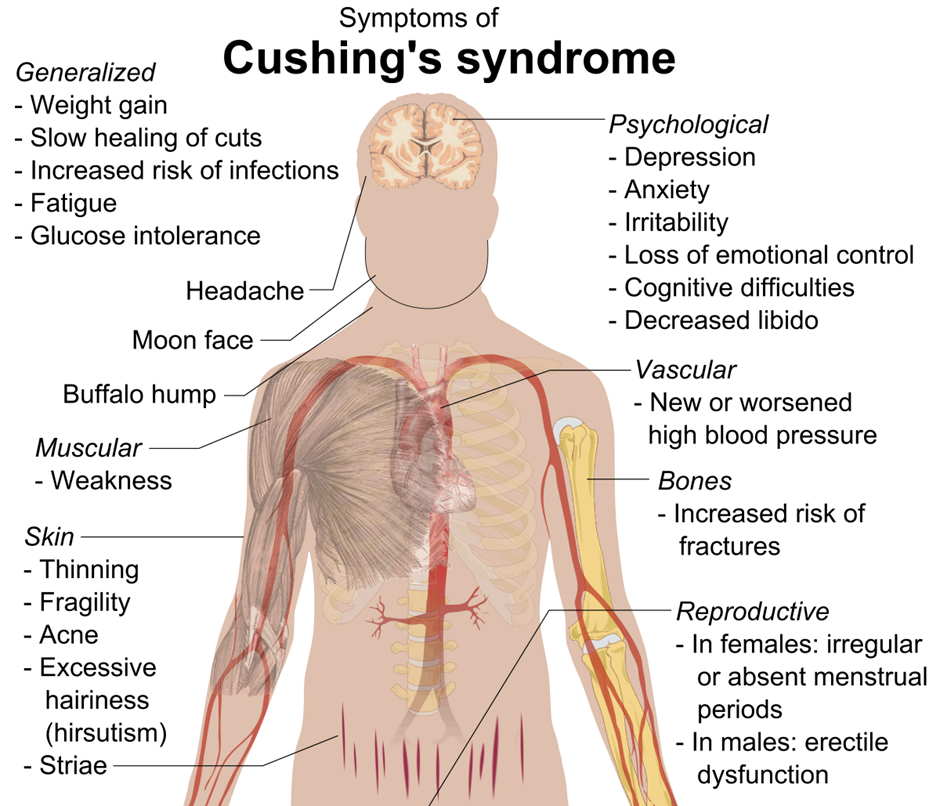A nurse is collecting data from a client who has Cushing's syndrome. Which of the following findings should the nurse expect?
Jaundice
Muscle rigidity
Weight loss
Easily bruised
The Correct Answer is D
Choice A Reason:
Jaundice, characterized by yellowing of the skin and eyes, is typically associated with liver dysfunction or conditions affecting the breakdown of red blood cells, not directly linked to Cushing's syndrome. While some liver abnormalities can be seen in Cushing's syndrome due to metabolic changes, jaundice is not a typical manifestation of this condition.
Choice B Reason:
Muscle rigidity is more commonly associated with conditions like Parkinson's disease, dystonia, or certain muscle disorders. In Cushing's syndrome, muscle weakness due to protein breakdown and muscle wasting is a more expected finding rather than muscle rigidity.
Choice C Reason:
Weight loss is incorrect. Weight gain, particularly in the central part of the body (trunk) and face (creating a "moon face"), is a more common characteristic of Cushing's syndrome. The excess cortisol often leads to increased fat deposits, especially in these areas, rather than weight loss.
Cushing's syndrome is characterized by an excess of cortisol in the body, either due to the body producing too much cortisol or from long-term use of corticosteroid medications. Considering this condition, the nurse should expect the following finding:
Choice D Reason:
Easily bruised is correct. Excess cortisol can lead to the thinning of the skin and weakening of blood vessels, making individuals with Cushing's syndrome prone to easy bruising. Other common findings associated with Cushing's syndrome include weight gain (especially in the trunk and face), muscle weakness, high blood pressure, fatigue, and changes in skin such as thinning and purple stretch marks.

Nursing Test Bank
Naxlex Comprehensive Predictor Exams
Related Questions
Correct Answer is B
Explanation
Choice A Reason:
Temperature 37.3°C (99.1°F) is incorrect . While a slightly elevated temperature can sometimes accompany an infection, it's not specific to a bladder infection and might not be present in all cases.
Choice B Reason:
Changed mental status is incorrect. Bladder infections or urinary tract infections (UTIs) in older adults can often present with atypical symptoms, and changes in mental status or acute confusion are common indicators in this population. UTIs can cause subtle but significant alterations in mental function, particularly in the elderly, leading to confusion, agitation, or cognitive impairment.
Choice C Reason:
WBC count 9,000/mm3 (5000 to 10,000/mm3) is incorrect .A WBC count within the normal range doesn't necessarily rule out or confirm a bladder infection. In some cases, UTIs might not significantly elevate the white blood cell count, especially in localized infections.
Choice D Reason:
Diminished reflexes is incorrect . Diminished reflexes are not typically associated with a bladder infection. They might indicate other neurological or muscular issues but are not a common sign of a UTI.
Correct Answer is D
Explanation
Choice A Reason:
"I wish my sexual relationship with my partner was like it was before." This statement indicates a desire to return to the previous state, implying a sense of dissatisfaction or longing for the way things were before the ileostomy surgery, rather than acceptance of the current situation.
Choice B Reason:
"I have my partner empty the bag for me, so I don't have to look at it."While having a partner assist with bag management might indicate some level of adaptation, the statement implies avoidance or discomfort in dealing directly with the ileostomy. It may suggest a lack of full acceptance or adjustment to the presence of the ileostomy.
Choice C Reason:
“I look forward to having normal bowel movements again." This statement expresses a desire to return to the previous bodily function, indicating a longing for the way things were before the surgery rather than complete acceptance of the ileostomy as a new way of managing bowel movements.
Choice D Reason:
"I will attend a support group to help me handle difficulties when they occur." Attending a support group demonstrates a proactive approach toward acceptance and adjustment to living with an ileostomy. It shows the client's willingness to seek support, learn coping strategies, and engage with others facing similar challenges.

Whether you are a student looking to ace your exams or a practicing nurse seeking to enhance your expertise , our nursing education contents will empower you with the confidence and competence to make a difference in the lives of patients and become a respected leader in the healthcare field.
Visit Naxlex, invest in your future and unlock endless possibilities with our unparalleled nursing education contents today
Report Wrong Answer on the Current Question
Do you disagree with the answer? If yes, what is your expected answer? Explain.
Kindly be descriptive with the issue you are facing.
